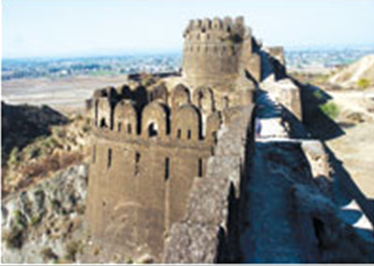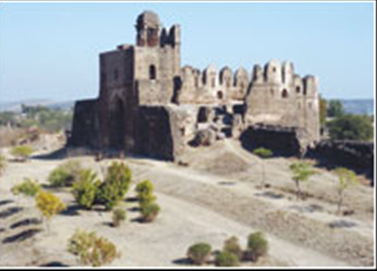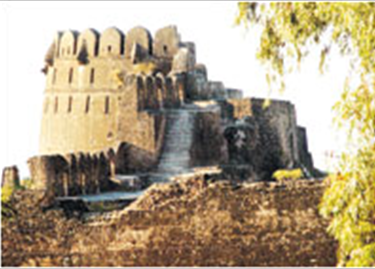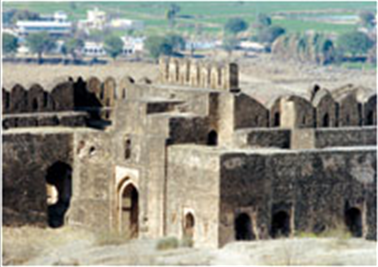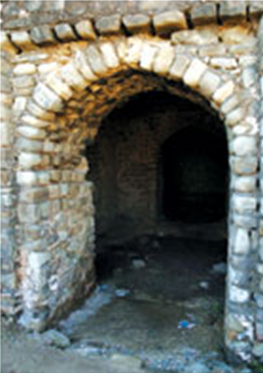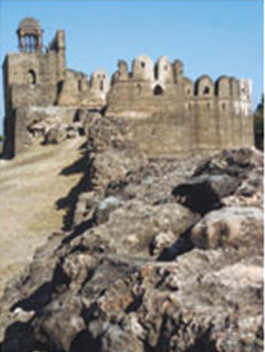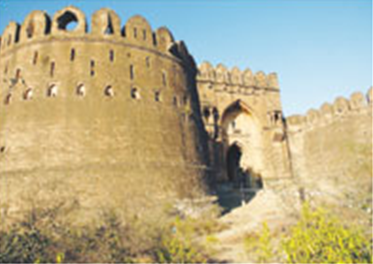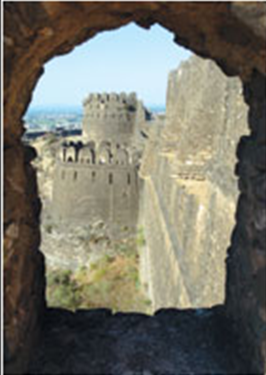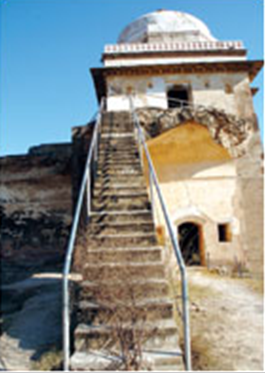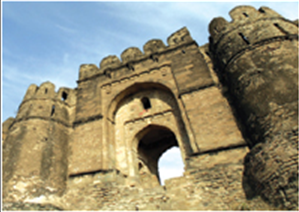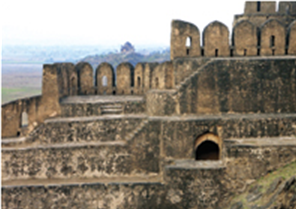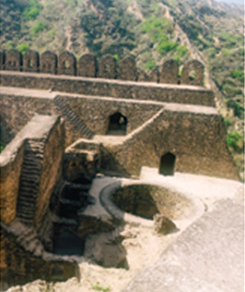Rohtas Fort
This is a collection of articles archived for the excellence of their content. Readers will be able to edit existing articles and post new articles directly |
Contents |
Rohtas Fort
Rohtas Fort
The majestic Rohtas Fort
By Arsalaan Haleem
Approximately 109 kilometres from Rawalpindi and 16 kilometres north-west of the city of Jhelum, lies one of the finest specimens of military fortifications ever constructed in our part of the world — the majestic Rohtas Fort.
Rohtas Fort, or Qila Rohtas (as locals like to call it), was commissioned by Sher Khan, better known as Sher Shah Suri, between 1540 – 1550 AD. Constructed on a low lying rocky hill, next to a gorge, which in its time also doubled as a wide moat to ward off possible invaders, is a classic example of the predominantly Pathan architectural style of the mediaeval times.
Named after an original site, where Suri once defeated Mughal forces, the fort is a symbol of strength and determination of its builder, Sher Khan, who constructed the fort to block Emperor Humayun’s return to India, as well as to defend against the possible onslaught of the Gakhars — the local warrior tribes, who were loyal to Humayun. The construction of the fort was supervised by one of his trusted generals; but was completed during the tenure of Jalal Khan, Sher Shah’s son and immediate successor.
The fort lies on an ancient route that runs southward to the fertile land of Indus Valley and eastward to the plains of Ganges, from the mountainous region of the north. The famous Grand Trunk Road, also constructed during Sher Shah’s tenure, passes along this route, connecting Kabul to Calcutta as well as various ancient and current cities along the way.
The area surrounding the fort is also famous for being the landing area for the famous Greek general Alexander’s troops during his conquest of the sub-continent.
Spread over an area of four kilometres, the fort’s sandstone parameter is a three-tiered structure, interconnected into three separate terraces, with the outer wall reaching a maximum height of 18.30 metres high, whereas at other places it is only 10 metres high. The widest portion is near the Mori gate with 12.4 metres.
Atop the outer walls, the embankments are strengthened by hundreds of merlon-shaped battlements with loop-holes for pouring down molten lead or oil onto the invaders. At various places, the inner walls have been hollowed out into galleries that may have been used either as sleeping quarters or storage vaults.
The most impressive features of Rohtas Fort are its 68 semi-circular bastions and the 13 grand stone arched gateways. These gates, though of different sizes and at irregular intervals, give the fort the awe-inspiring nature that it posses. These are: Langer khana, Shishi, Kabuli, Gaddaiwala, Sohail, Sar, Pipalwala, Tulla Mori, Gatiali, Khawas Khani, Kashmiri, and the Shan Chandwali Gate, the last mentioned is the only gate that opens into the inner courtyard, the rest are part of the outer parameter.
Though all the gates provide an entry route, the main entrance is through the Khawas Khani gate on the eastern side. The main path, then forks out into two: one leads to the ancient settlement of Rohtas and the other to Anderkot — living-quarters inside the fort — and to the southern Sohail Gate.
The thriving village of Rohtas has been in existence from the times of Jamal Khan and comprises several neighbourhoods, divided by a main road, which due to its antiquity have been declared a Heritage Street.
Of the original buildings of the inner courtyard, only two — Shahi Mosque and Haveli Man Singh, named after one of Emperor Akbar’s generals, survive today. Three deep step-wells, most probably constructed during the time of Sher Khan, are also in good shape.
Though the fort has withstood the elements for almost five centuries, its strong structure has started to crumble. The ravages of human occupancy have defaced and even destroyed certain areas of the massive structure. Sadly, people visiting this tourist site do not respect its cultural value and its history and leave traces of their visits by defacing the walls and littering around.
Lack of knowledge and importance of this monument have brought about a mindset of apathy from the locals living in and around the fort, which has also played a part in the fort’s destruction. Lack of proper planning and government’s empathetic interest has let to a large squalid dwellings develop around the fort that causes further damage to the historical monument.
Being one of the handful forts of Middle Ages in the world today, Rohtas Fort is listed in the Unesco’s World Heritage List of 1997 and is also protected by the Antiquities Act of 1975 by the Federal Government of Pakistan.
Supported by Pakistani and Norwegian Governments, and co-sponsored by an oil marketing company, an international conservations organisation, The Himalayan Wildlife Foundation (HWF) is engaged in the restoration and conservation of the monument since 2001 and is running many projects under the Rohtas Fort Conservation Programme. It hopes to restore it to its former glory soon.
Rohtas Fort2
An architectural marvel
Text and photographs by Tanveerul Islam
Located near Jhelum off the Grand Trunk (GT) Road, Rohtas Fort was built by Sher Shah Suri, the Afghan ruler known for his adminstrative skills during his five-year rule in the subcontinent. The fort is one of the most imposing historical monuments in Punjab and is situated on the edge of the Kahan gorge, which provided the only route from the mountainous area north of the Salt Range to the southern plains.
Sher Shah constructed Rohtas Fort to block Emperor Humayun’s return to India after defeating him in the Battle of Kanauj. To intercept his return to India Suri garrisoned his troops along the route between Lahore and Peshawar.
The other reason for the fort was to suppress the local tribes called Gakhars who were allies of Humayun and refused their allegiance to him. The Gakhars made a feeble retort by building some fortifications near the village of Sultanpur, which still remain today. Begun in 1541, it took almost eight years to built this magnificent garrison fort.
The fort derives its name after the Rohtasgarh fort in Bihar which Sher Shah had captured from the Raja of Rohtas, Hari Krishan Rai in 1539. Owing to its awe-inspiring features of strength and massiveness, and being the finest example of mediaeval military architecture in Pakistan, Unesco included the fort in the World Heritage List, in 1997.
The fort is a unique piece of cultural heritage for the people. Built in sandstone the height of the wall varies between 10 and 18 meters whereas its thickness is between 10 to 13 meters. Interestingly the fort has never been under seige in the past.
About four kilometers in circumference the fort houses shrines, a mosque, an execution tower and three baowlees (water reserviors made by cutting deep into the rock). There are no buildings inside the fort except the Haveli Maan Singh named after Akbar's famous general.
Most of the fort is in good state of preservation but at places the walls are falling off. The vast tracts inside the fort have been turned into a jungle. To bring the fort in its original state requires not only huge funds and expertise but a commitment on the part of both the government and the NGO sector.
Rohtas Fort3
A historical marvel
By Mahnaz Kazim
The colossal Rohtas Fort is one extraordinary example of military architecture in our part of the world
SPRAWLING across a low rocky hill a few miles north of Jehlum stands a magnificent fort on a hill 130ft above ground and is set on a ridge protected on its southern side by a deep ravine. One of the most extraordinary examples of military architecture in the subcontinent, this is the colossal Rohtas Fort or Qila Rohtas.
The site of the fort is on an ancient route to India used by traffic coming from north of the Salt Range to the plains south of it. Here, the Kahan River, after passing through the low-lying hills of the Tarahi Range, enters into relatively flat ground. The plan of the fort is adapted to suit the terrain and is defended by a number of deep ravines, as well as the river, along most of the perimeter wall.
Rohtas is one of the most imposing historical monuments which represents the Pathan period of architecture style in Pakistan. The fort is the symbol of strength and determination of its builder Sher Shah Suri who ruled over India only for six years (1540-45AD) but even during that short period he created many splendours including Rohtas and the Great Grand Trunk Road, connecting Kabul with Calcutta.
The area of the fort extends over almost five kilometres in perimeter. With its undulating stone walls and intimidating massive towers, it remains even today a solid gauntlet of weathered stone, a formidable challenge to those who aspire to explore it.
The first glimpse of the Rohtas fills the mind with its majesty and splendour. The fort is now in ruins but what ruins they are. These include massive battlements and walls, 30 to 50 feet high fortification walls, 68 towers and 12 gates.
The four-kilometre fortification wall consists of two or three tiers, the outermost tier towering almost 18m and protected by 68 semi-circular bastions. The fort’s ramparts are also protected by more than 2,000 merlon-shaped battlements provided with loop-holes used to pour molten lead or oil onto besiegers. Portions of the inner wall have been hollowed out into galleries that were used as storage vaults.
The fort’s most arresting features are its 12 arched gateways. No two gates are alike, nor do they occur at regular intervals. Overlooking the Kahan River from the western ramparts are four gates: Kabuli, Shishi, Langar Khani and Talaqi; guarding the northern walls are the Kashmiri, Khawas Khani and Gatiali gates; facing the Tilla hills to the south are the Sohail and Sar gates, and to the east, the Tulla Mori and Pipalwala gates. A twelfth gate, Shahchandwali, opens the inner citadel east into the rest of the fort.
Few of the original buildings erected within the inner citadel survive today. These include the Shahi Mosque built near the Kabuli Gate, and three deep step-wells or baolis probably dating back to the Suri period, one to the west near the Kabuli Gate, a second on the east side of the fort near Tulla Mori Gate, and a third just inside the Langar Khani Gate. Perhaps the most enigmatic building within Rohtas remains Haveli Man Singh: the domed tower named after one of Akbar’s greatest generals, and the only surviving example of Hindu architecture within the fort.
The main entrance to the fort is through the eastern Khawas Khani Gate. The road then forks, one path leading to the Anderkot and the Sohail Gate, and the other to the village of Rohtas. This thriving settlement has existed within the outer citadel for centuries, and is now recognized as an antiquity in its own right. It comprises several mohallas or neighbourhoods divided by a main road that has now been converted into a “heritage street”.
Not only has Rohtas been exposed to the test of time; many tourists visiting the site deface the walls of the fort with unwarranted graffiti. Merely a few years ago, squatters camped in the inner enclaves of the fort, exposing it to further deterioration and disintegration. A lack of information and knowledge about the importance of this historical site led to burgeoning problems for the natives living around this area for centuries. Squalid dwellings started developing in the vast area encompassing the fort.
A non-profit organisation, aided by both the public and private sector entities, is for the last few years trying to ensure that the communities living in and around Rohtas benefit from the conservation of this historical legacy.
The restoration and conservation process will eventually attract a greater number of tourists, primarily from within Pakistan and in time from around the world. The conservation team for Rohtas has not only tirelessly worked towards restoring the edifice to its original grandeur, but has given equal importance to improving the living conditions of the villagers. In this regard the Norwegian government was approached to help develop a viable solid waste management programme. By creating a decent, sanitary place for people to live, the conservation team aim to bring the fort back to life, help the people, provide for a decent future and preserve the cultural past.
While the restoration work continues on the fort, a tourist infrastructure is also being set up with a visitor’s gallery and information centre, an antiquity museum, a parking lot and a public toilet.
The route of restoration and conservation is also helping in providing employment and skill training to the locals. The same community is being encouraged to initiate small businesses for the increasing number of visiting tourists, which helps generate employment.
To supplement funding for the conservation project, a fund- raiser was held recently. Many of the local people were successfully employed in the production as well as performance areas. Funded by a petroleum giant, the wonderful sound and light show attracted about 450 corporate clients and an acknowledgement from the prime minister of Pakistan.
Rohtas is now a protected monument under the Antiquities Act 1975, and is maintained by the Department of Archaeology. Rohtas was inscribed on the World Heritage List by Unesco in 1977, owing to its marvellous qualities of strength and solidity, and being the finest specimen of mediaeval military architecture in Pakistan.
